Blade Embellishments
Almost all historical blades are embellished in one way or another. Be it a swordsmith’s mark, a fuller inscription or decorative patterns of lines and dots.
Understanding the techniques artisans applied to achieve different effects and reviving them today gives reproductions a more “authentic” look and feel.
Embellishment Techniques
First, I will give you an overview of the variety of techniques that artisans have applied in the past to turn sword and dagger blades into eyecatchers. The examples presented are blades from the 15th to the 18th century located in different museums (see footnotes for details).
Hot Stamping
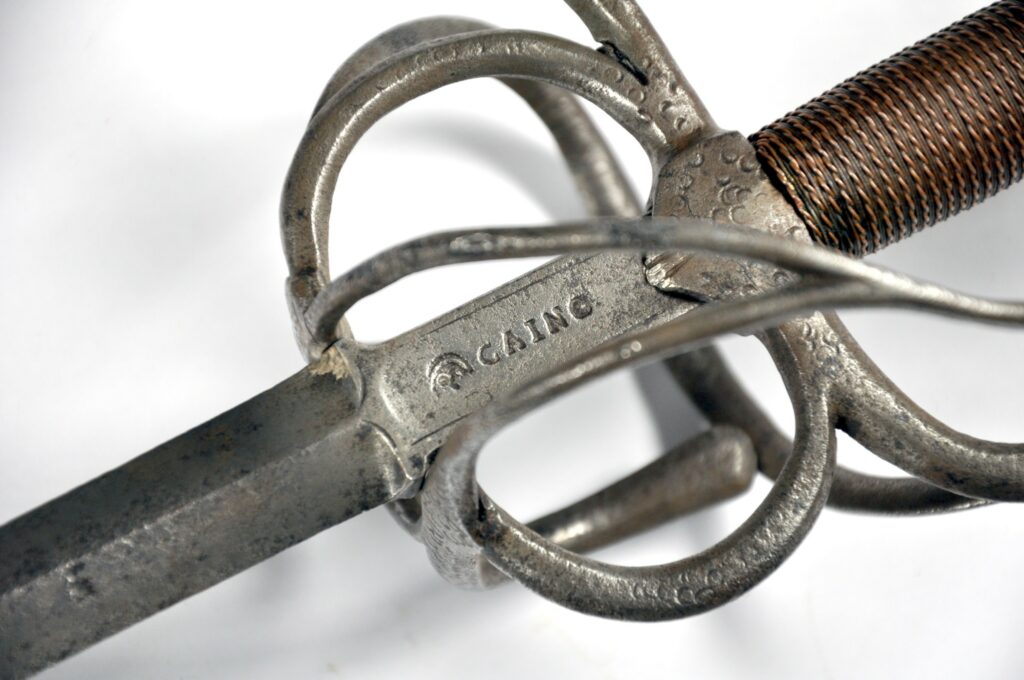
Hot stamping is a quick and highly visible way to add symbols, marks and letters to a blade’s surface. It allows the impression of complex shapes or lettering with one stroke of a hammer.
This technique has been commonly used for bladesmith’s marks, origin marks (the city of Toledo or Milan for example) and predefined sequences of letters like “CAINO” “IHS” or the name of the smith like “ANDREA / FERARO” (Andrea Ferrara) for example. Metallurgical analysis of blades provides proof for this, as the microstructure of the steel follows the impressions made into the metal.2 3
Cold Stamping

Similar to hot punching, yet applied to cold, annealed steel. This method allows more flexibility and detail as there is no time constraint of the quickly cooling steel. As surface areas have to be smaller to give a well visible impression, only elements of letters, or small symbols like dots, stars or crosses can be punched. This can be deduced from varying letter shapes and misaligned punch impressions.
This technique has been used for some fuller inscriptions and blade ornamentation.
Piercing
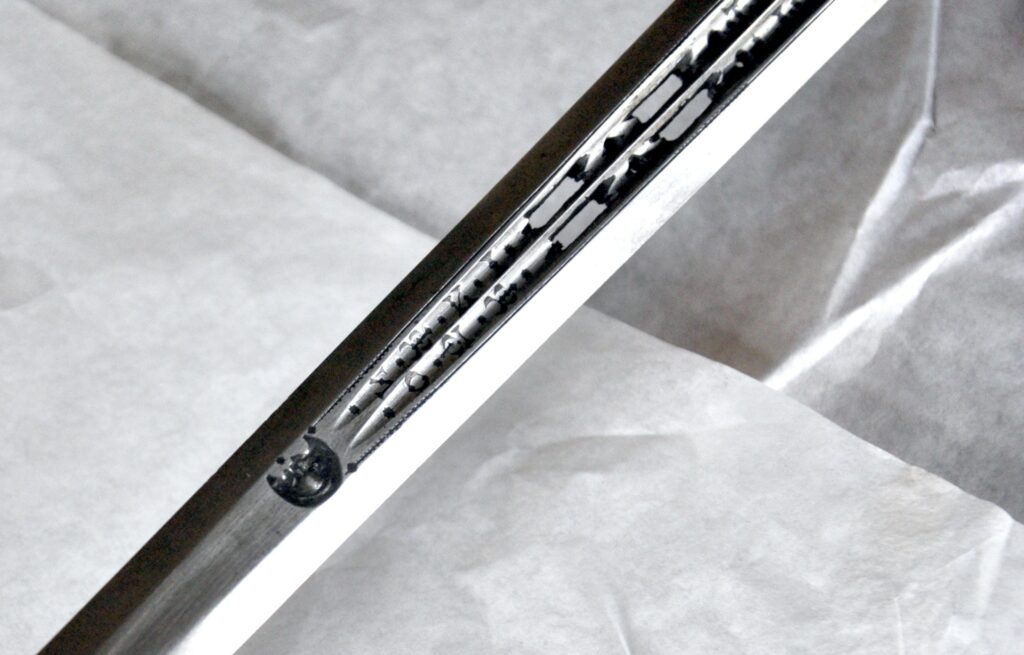
Piercing is a method with great visual impact, as it adds a sense of fragility to a blade. It has been applied inside fullers of swords and daggers. Piercing is usually not intended to reduce weight, its function is just an aesthetic one (only certain parrying dagger’s blades show a noticeable weight reduction in conjuction with mutliple, deep grooves).
Engraving
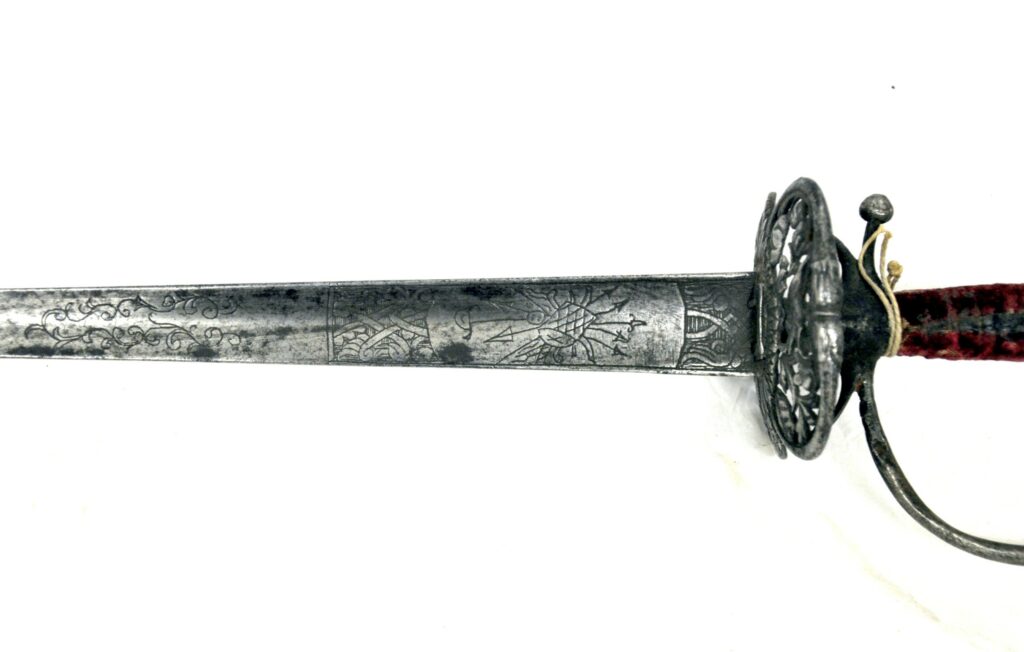
Steel gravers and chisels are used to incise patterns into the steel surface. With this time consuming technique, an artist can apply lines, ornaments, inscriptions and symbolic imagery on the blade. Also marks of larger size unsuitable for hot stamping, like the famous “wolf of Passau” have been made this way.
Inlay Work & Damascening
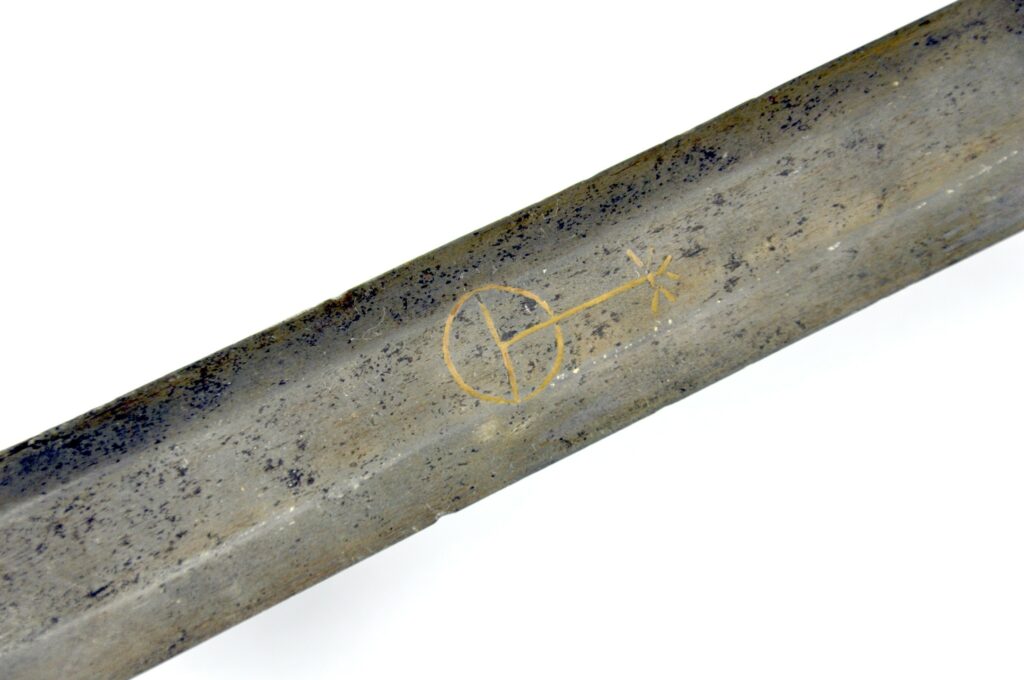
Engravings can be inlaid (damascened) with other metals. Brass, copper, silver and gold have been used depending on the desired effect, color and budget of the customer.
Etching
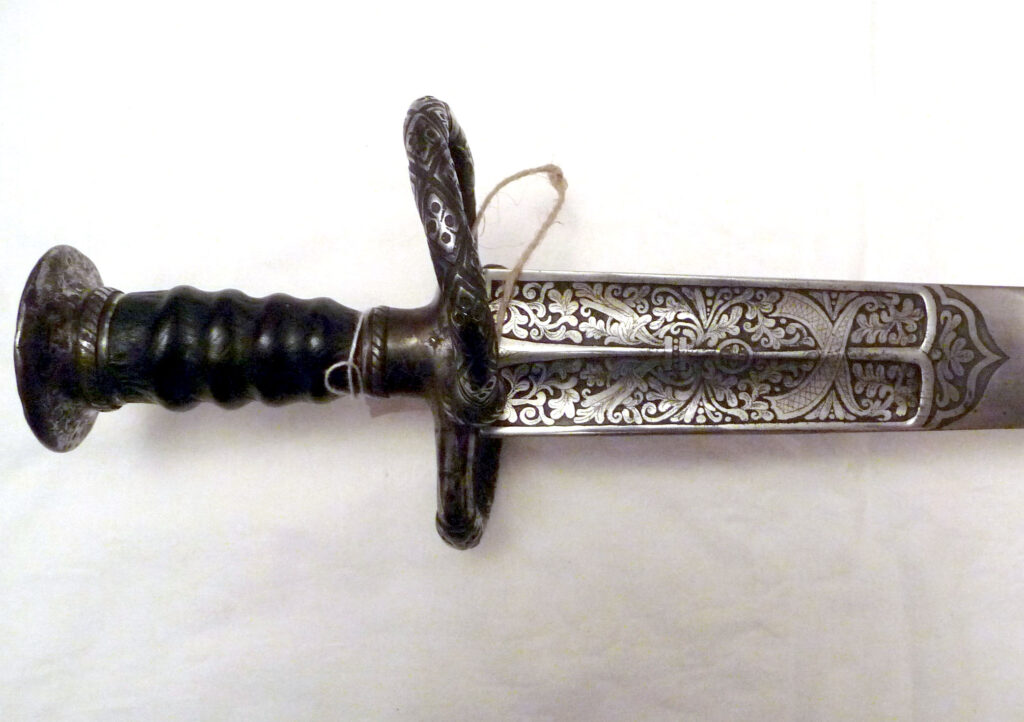
Etching is a technique that allows for great artistic freedom and detail while being less time consuming than engraving. Though preferably applied to high-end plate armour, it has also been used on blades. Frequent polishing will remove the etching eventually, as it is not as deep as an engraving or stamping.
Embellishment Themes
We have seen how decoration can be applied to the blade surface. Now we will look at the “content”.
Names
The most common sword inscriptions are names. Usually the name of the blade smith. Sometimes abbreviated, sometimes with very bad spelling. For example: Andrea Ferrara, Tomas Ayala, Jvan Martin (Juan Martinez), Piccinino, Clemens Horn, etc.
Those names were brands in the past. It was a widespread custom to mark plagiarised blades with names of famous smiths, for example blades from Solingen were stamped with marks and names from Toledo.
Religious phrases
Bible verses, invocations and other religious phrases were also common themes.
For example:
- D.O.M. (Deo Optimo Maximo – “to the greatest and best god”)
- IHS (Iota Eta Sigma – a christogram, the first three letters of the greek name of Jesus)
- I.N.R.I. (Iesus Nazarenus Rex Iudaeorum – “Jesus, king of the Jews”)
- IN TE DOMINE SPERAVI NON [CONFUNDAR IN AETERNUM] (“In thee, O lord, do I take refuge; let me never be put to shame” – used by Juan Martinez the elder)7
Personal Mottoes
Less common, but still popular (especially from the 17th c. onwards) were personal mottoes, like “respice finem” (look to the end, consider the end result of your actions)
Graphical Symbols/Patterns
Another theme of fuller inscription were, sometimes repeated, glyphs like Xs, crosses, circles, other patterns or mysterious strings of letters (probably abbreviations only known to the owner).
- 1.Fortner F, Schrattenecker J, Rapp K. Detailed Measurement of Edged Weapons from the Gotti Collection. De Lo Schermo. http://www.rapier.at/2018/07/13/detailed-measurment-of-edged-weapons-from-the-mam-martial-arts-museum-botticino-roberto-gotti-collection/. Published 2018. Accessed 2020.
- 2.Gotti R, Minuzzi G. Caino. Punto Marte; 2011.
- 3.Gener M. Metallographic Study of Some 17th and 18th c. European Sword (Rapier) Blades. In: Aquileia, Italy; 2007.
- 4.Fortner F, Schrattenecker J. A Comparison of Late 16th to Early 17th Century Rapiers with Modern Reproductions. De Lo Schermo. http://www.rapier.at/2015/10/28/a-comparison-of-late-16th-to-early-17th-century-rapiers-with-modern-reproductions/. Published 2015. Accessed 2020.
- 5.Fortner F, Schrattenecker J. Detailed Measurement of Edged Weapons from the Wiener Heeresgeschichtliches Museum – English Translation. De Lo Schermo. http://www.rapier.at/2016/06/06/detailed-measurement-of-edged-weapons-from-the-wiener-heeresgeschichtliches-museum-english-translation/. Published 2016. Accessed 2020.
- 6.Fortner F, Schrattenecker J. Detaillierte Vermessung von Blankwaffen der Sammlung Klingelmayer. De Lo Schermo. http://www.rapier.at/2017/12/07/detaillierte-vermessung-von-blankwaffen-der-sammlung-klingelmayer/. Published 2017. Accessed 2020.
- 7.Marek L. Rapiers by Juan Martinez the Elder – The Royal Sword-Smith from Toledo Found in Poland. FASC. 2014;27:87-97.
